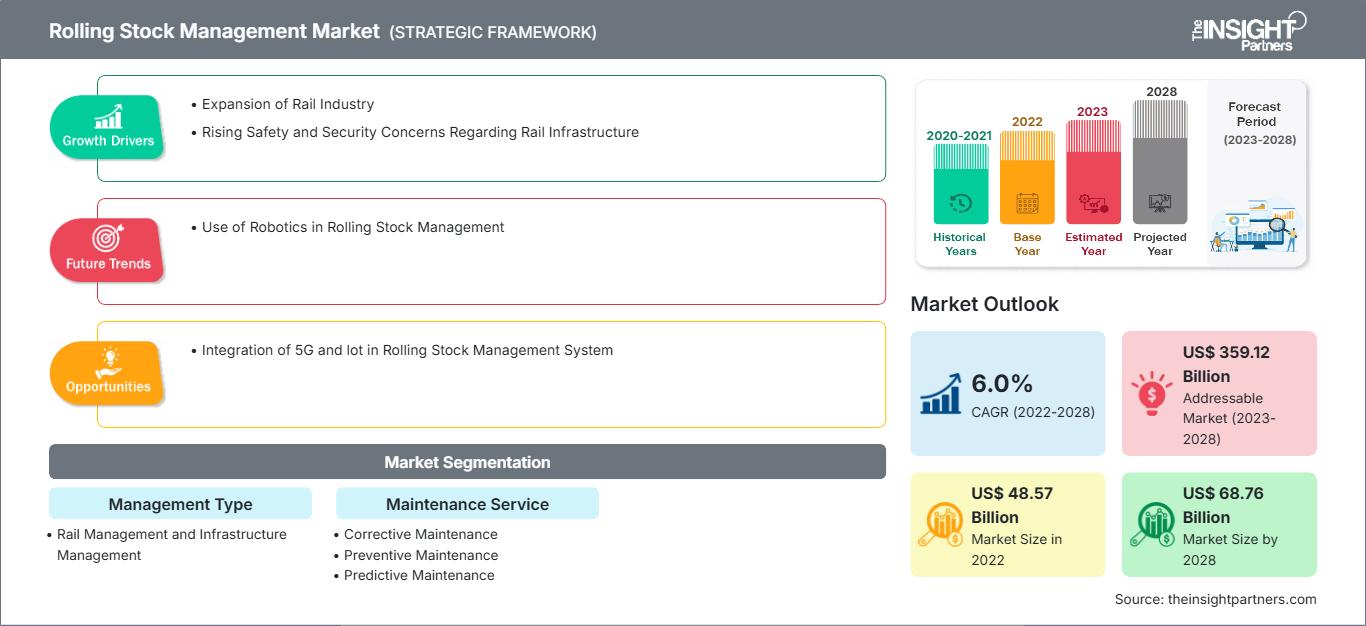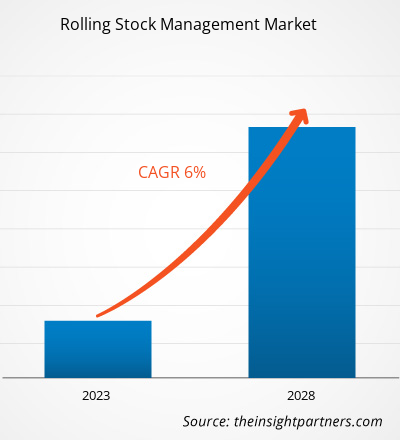[Informe de investigación] El mercado de gestión de material rodante se valoró en US$ 48.571,46 millones en 2022 y se espera que alcance los US$ 68.761,96 millones para 2028; se estima que registrará una CAGR de 6,0% de 2022 a 2028.
Perspectiva del analista:
El material rodante se refiere a los vehículos ferroviarios, tanto con motor como sin él. Se refiere a cualquier vehículo ferroviario que pueda circular por las vías. El mantenimiento, el seguimiento de la información y la gestión del material rodante son las características clave del sistema de gestión de material rodante. Este sistema mantiene la información sobre el funcionamiento, así como los registros de averías e inspección del material rodante. También almacena los registros del material rodante desde su fabricación hasta la información sobre sus principales accesorios. La gestión del historial del material rodante ayuda a los trabajadores, durante su inspección y avería, a gestionar eficientemente su trabajo. Además, este sistema facilita la conexión de esta información con los sistemas de gestión del tráfico, los sistemas de materiales y contabilidad, los planes de transporte, etc. Por lo tanto, el sistema de gestión de material rodante es necesario para determinar el rendimiento óptimo del material rodante y de la industria ferroviaria.
Descripción general del mercado: mercado de gestión de material rodante
El auge de la industria ferroviaria es uno de los principales factores que contribuyen al mercado de la gestión de material rodante. El creciente número de nuevas estaciones y la expansión de la red ferroviaria generan la necesidad de un sistema eficiente de gestión de material rodante para gestionar el material rodante, sus rutas y su mantenimiento.
A continuación se mencionan algunas de las principales estaciones y proyectos de expansión ferroviaria:
- En marzo de 2022, Saudi Arabia Railways (SAR) inauguró la estación de trenes de pasajeros de Al-Qurayyat en el marco del plan de SAR de lanzar trenes de pasajeros en dirección norte.
- En marzo de 2023, la Autoridad de Ferrocarriles Centrales de la India (CR) anunció su plan para construir seis nuevas estaciones de trenes suburbanos para atender a los trenes locales de Bombay. CR Bombay cuenta con 80 estaciones, y con la incorporación de estas seis, el total ascenderá a 86.
Obtendrá personalización en cualquier informe, sin cargo, incluidas partes de este informe o análisis a nivel de país, paquete de datos de Excel, así como también grandes ofertas y descuentos para empresas emergentes y universidades.
Mercado de gestión de material rodante: perspectivas estratégicas

-
Obtenga las principales tendencias clave del mercado de este informe.Esta muestra GRATUITA incluirá análisis de datos, desde tendencias del mercado hasta estimaciones y pronósticos.
Impulsor del mercado: Mercado de gestión de material rodante
Expansión de la industria ferroviaria
La demanda de mejores servicios de transporte está creciendo rápidamente en todo el mundo. Según la Agencia Internacional de Energía (AIE), en comparación con 2019, se espera que las actividades de pasajeros y mercancías se dupliquen para 2050. Según el Grupo del Banco Mundial, los ferrocarriles se consideran una de las formas más eficientes de transportar pasajeros y mercancías. Debido al crecimiento de las actividades de transporte, el Grupo del Banco Mundial está invirtiendo en el desarrollo de la industria ferroviaria para que sea más eficiente. Muchas organizaciones están extendiendo su apoyo a los gobiernos de varios países en desarrollo en la reforma de la infraestructura ferroviaria y la incorporación de los ferrocarriles en la red de transporte de un país. Además, los gobiernos de los países en desarrollo están invirtiendo para impulsar su industria ferroviaria. Según la India Brand Equity Foundation, para 2030, el país invertirá ~US$ 715.41 mil millones para infraestructura y desarrollo ferroviario. Para gestionar el aumento del tráfico de pasajeros y mercancías, los países están ampliando su infraestructura ferroviaria. Por ejemplo, en septiembre de 2022, el Departamento de Transporte de Connecticut (CTDOT) inauguró una nueva estación de tren en el condado de Hartford, EE. UU. Además, en enero de 2022, el Ministro de Inversiones de Arabia Saudita anunció el objetivo del país de ampliar la red ferroviaria en 8.000 km. El sistema de gestión del material rodante contribuye a optimizar su rendimiento. El auge de la expansión y el desarrollo de la industria ferroviaria está generando una demanda de material rodante como locomotoras, vagones de mercancías y trenes de pasajeros, lo que impulsa aún más la demanda de un sistema eficiente de gestión del material rodante.
Análisis segmentario: mercado de gestión de material rodante
Según el tipo de gestión, el mercado de gestión de material rodante se divide en gestión ferroviaria e infraestructura. Según el servicio de mantenimiento, se clasifica en mantenimiento correctivo, preventivo y predictivo. Geográficamente, el mercado de gestión de material rodante se segmenta en Norteamérica, Europa, Asia Pacífico, Oriente Medio y África, y Sudamérica.
Análisis regional: mercado de gestión de material rodante
El mercado de gestión de material rodante se clasifica en cinco regiones principales: Norteamérica, Europa, Asia Pacífico (APAC), Oriente Medio y África (MEA) y Sudamérica (SAM). El crecimiento del mercado global de gestión de material rodante aéreo se atribuye al aumento del tráfico de pasajeros y al incremento de estaciones ferroviarias. La mayoría de las redes ferroviarias convencionales se encuentran en Norteamérica, Europa y APAC. Según datos de la Administración Federal de Tránsito de 2019, estas regiones representan aproximadamente el 90 % del movimiento global de pasajeros en un ferrocarril convencional, con India a la cabeza con el 39 %, seguida de China con el 27 %, Japón con el 11 % y la Unión Europea con el 9 %. El creciente número de infraestructuras y pasajeros está impulsando la necesidad de adquirir este material rodante para satisfacer la demanda de mayores servicios de mantenimiento. Por lo tanto, el aumento en el número de estaciones ferroviarias está impulsando la demanda de servicios de gestión de material rodante para la eficiencia, la fiabilidad y la seguridad entre los ferrocarriles y las estaciones, impulsando el mercado de gestión de material rodante.
Análisis de actores clave: Mercado de gestión de material rodante
Algunas de las principales empresas que operan en el mercado de la gestión de material rodante son Alstom SA, Hitachi Rail Ltd, ABB Ltd, Mitsubishi Electric Corp, Siemens Mobility GmbH, Talgo SA, Thales SA, Toshiba Infrastructure Systems and Solutions Corp, Trimble Inc y LocoTech LLC. Muchas empresas están invirtiendo en la gestión de material rodante debido a las posibles mejoras en la precisión, la eficiencia operativa y el cumplimiento puntual de los pedidos.
Perspectivas regionales del mercado de gestión de material rodante
Los analistas de The Insight Partners han explicado detalladamente las tendencias regionales y los factores que influyen en el mercado de gestión de material rodante durante el período de pronóstico. Esta sección también analiza los segmentos y la geografía del mercado de gestión de material rodante en América del Norte, Europa, Asia Pacífico, Oriente Medio y África, y América del Sur y Central.
Alcance del informe de mercado de gestión de material rodante
| Atributo del informe | Detalles |
|---|---|
| Tamaño del mercado en 2022 | US$ 48.57 mil millones |
| Tamaño del mercado en 2028 | US$ 68.76 mil millones |
| CAGR global (2022-2028) | 6.0% |
| Datos históricos | 2020-2021 |
| Período de pronóstico | 2023-2028 |
| Segmentos cubiertos |
Por tipo de gestión
|
| Regiones y países cubiertos |
América del norte
|
| Líderes del mercado y perfiles de empresas clave |
|
Densidad de actores del mercado de gestión de material rodante: comprensión de su impacto en la dinámica empresarial
El mercado de gestión de material rodante está creciendo rápidamente, impulsado por la creciente demanda de los usuarios finales debido a factores como la evolución de las preferencias de los consumidores, los avances tecnológicos y un mayor conocimiento de las ventajas del producto. A medida que aumenta la demanda, las empresas amplían su oferta, innovan para satisfacer las necesidades de los consumidores y aprovechan las tendencias emergentes, lo que impulsa aún más el crecimiento del mercado.

- Obtenga una descripción general de los principales actores clave del mercado de gestión de material rodante
Desarrollos recientes: Mercado de gestión de material rodante
Las estrategias inorgánicas y orgánicas, como las fusiones y adquisiciones, son ampliamente adoptadas por las empresas del mercado de gestión de material rodante. A continuación, se enumeran algunos desarrollos clave recientes en este sector:
- En 2023, Alstom firmó un contrato con la Autoridad Portuaria de Nueva York y Nueva Jersey y el Aeropuerto Internacional Newark Liberty para brindar servicios de operación y mantenimiento para su sistema de monorraíl Innovia, AirTrain Newark, durante los próximos siete años hasta enero de 2030. El contrato está valorado en más de US$ 260 millones e incluye una opción por un año adicional.
- En 2023, ABB recibió pedidos por valor de 170 millones de dólares de Stadler, una multinacional suizo-sueca, para impulsar más de 300 nuevos trenes y locomotoras. Los trenes se utilizaron en diversas redes ferroviarias europeas para modernizar y reforzar el transporte ferroviario en países como el Reino Unido, España, Portugal, Alemania y Austria, así como en algunos corredores ferroviarios europeos.
- En 2023, Siemens Mobility entregó 1200 locomotoras eléctricas y prometió 35 años de mantenimiento integral. Este se considera el mayor pedido de locomotoras en la historia de Siemens Mobility y de Siemens India. Con ello, Siemens Mobility ha consolidado su posición en el mercado.
- En 2022, Thales presentó a las partes interesadas una nueva tecnología ferroviaria que mejoró la seguridad de la red ferroviaria del Reino Unido para los trabajadores de las vías, las tripulaciones y los pasajeros. Thales colaboró con Network Rail y West Somerset Railway (WSR) para realizar una demostración en vivo de su Sistema de Protección y Advertencia de Trenes - Supervisión Continua (TPWS-CS).
- Análisis histórico (2 años), año base, pronóstico (7 años) con CAGR
- Análisis PEST y FODA
- Tamaño del mercado, valor/volumen: global, regional y nacional
- Industria y panorama competitivo
- Conjunto de datos de Excel
Informes recientes
Informes relacionados
Testimonios
Razón para comprar
- Toma de decisiones informada
- Comprensión de la dinámica del mercado
- Análisis competitivo
- Información sobre clientes
- Pronósticos del mercado
- Mitigación de riesgos
- Planificación estratégica
- Justificación de la inversión
- Identificación de mercados emergentes
- Mejora de las estrategias de marketing
- Impulso de la eficiencia operativa
- Alineación con las tendencias regulatorias






















 Obtenga una muestra gratuita para - Mercado de Gestión de Material Rodante
Obtenga una muestra gratuita para - Mercado de Gestión de Material Rodante